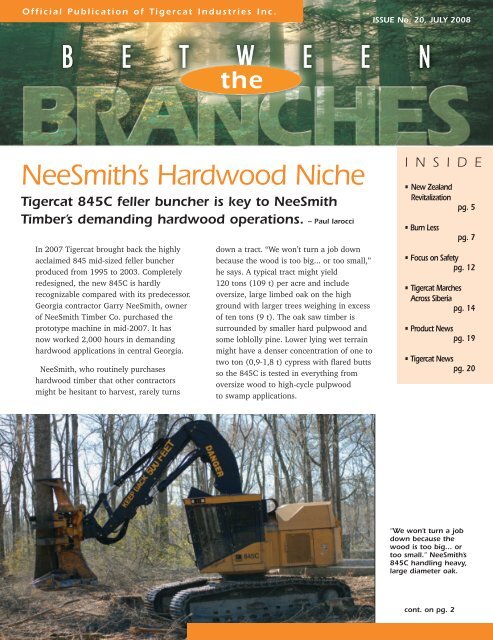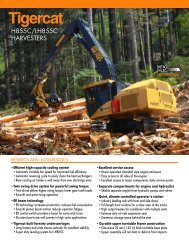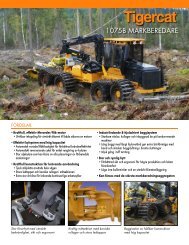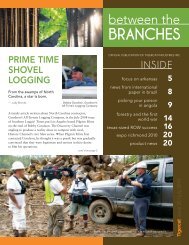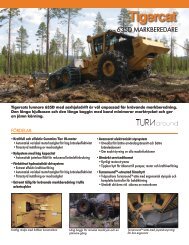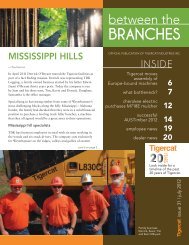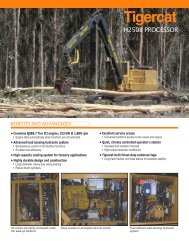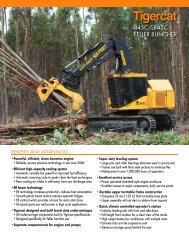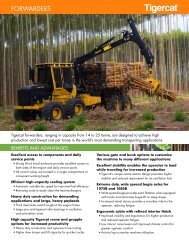NeeSmith's Hardwood Niche - Tigercat Industries Inc.
NeeSmith's Hardwood Niche - Tigercat Industries Inc.
NeeSmith's Hardwood Niche - Tigercat Industries Inc.
You also want an ePaper? Increase the reach of your titles
YUMPU automatically turns print PDFs into web optimized ePapers that Google loves.
Official Publication of <strong>Tigercat</strong> <strong>Industries</strong> <strong>Inc</strong>.<br />
NeeSmith’s <strong>Hardwood</strong> <strong>Niche</strong><br />
<strong>Tigercat</strong> 845C feller buncher is key to NeeSmith<br />
Timber’s demanding hardwood operations. -- Paul Iarocci<br />
In 2007 <strong>Tigercat</strong> brought back the highly<br />
acclaimed 845 mid-sized feller buncher<br />
produced from 1995 to 2003. Completely<br />
redesigned, the new 845C is hardly<br />
recognizable compared with its predecessor.<br />
Georgia contractor Garry NeeSmith, owner<br />
of NeeSmith Timber Co. purchased the<br />
prototype machine in mid-2007. It has<br />
now worked 2,000 hours in demanding<br />
hardwood applications in central Georgia.<br />
NeeSmith, who routinely purchases<br />
hardwood timber that other contractors<br />
might be hesitant to harvest, rarely turns<br />
down a tract. “We won’t turn a job down<br />
because the wood is too big... or too small,”<br />
he says. A typical tract might yield<br />
120 tons (109 t) per acre and include<br />
oversize, large limbed oak on the high<br />
ground with larger trees weighing in excess<br />
of ten tons (9 t). The oak saw timber is<br />
surrounded by smaller hard pulpwood and<br />
some loblolly pine. Lower lying wet terrain<br />
might have a denser concentration of one to<br />
two ton (0,9-1,8 t) cypress with fl ared butts<br />
so the 845C is tested in everything from<br />
oversize wood to high-cycle pulpwood<br />
to swamp applications.<br />
ISSUE No. 20, JULY 2008<br />
I N S I D E<br />
New Zealand<br />
Revitalization<br />
Burn Less<br />
cont. on pg. 2<br />
pg. 5<br />
pg. 7<br />
Focus on Safety<br />
pg. 12<br />
<strong>Tigercat</strong> Marches<br />
Across Siberia<br />
pg. 14<br />
Product News<br />
pg. 19<br />
<strong>Tigercat</strong> News<br />
pg. 20<br />
“We won’t turn a job<br />
down because the<br />
wood is too big... or<br />
too small.” NeeSmith’s<br />
845C handling heavy,<br />
large diameter oak.
2<br />
cont. from pg. 1<br />
Garry, J. Hall<br />
and Tidewater<br />
(Hazlehurst)<br />
salesman Reece<br />
Mincey<br />
NeeSmith says the<br />
new 250B produces<br />
more and burns less<br />
fuel than the older<br />
240B model that<br />
works alongside it.<br />
Because NeeSmith works private land, he<br />
goes the distance for his clients, fi rst clearing<br />
all the pulpwood and non-merchantable<br />
timber, then going after the high value saw<br />
logs. “The understorey all has to come out,”<br />
explains operations manager, Jason Wilson,<br />
“so that the new growth is all racing at the<br />
same time for the same sunlight. It comes<br />
out fi rst and goes to the pulp mill. If you<br />
don’t cut it fl at, the remaining trees will<br />
grow back bushy.”<br />
The saw logs -- up to ten inch (25 cm) tops<br />
-- go to Battle Lumber Co. in Wadley, GA,<br />
the largest hardwood mill in the region. The<br />
highest grade logs are sawed and shipped<br />
overseas for furniture making. Second grade<br />
logs are milled for fl ooring and bottom<br />
grade logs are raw material for pallets. The<br />
cypress logs are used to make panelling,<br />
beams, fl ooring and milled for use in boat<br />
construction.<br />
The <strong>Tigercat</strong> S860C shovel logger doesn’t<br />
just work the low lying areas. NeeSmith uses<br />
it to clean up the site, piling the limbs and<br />
tops which are also transported to the deck.<br />
Four to ten inch (10-25 cm) tops and limbs are<br />
processed, sorted and sent to the pulp mill.<br />
The end result for the landowner is a clean<br />
parcel of land, free of waste fi bre and ready<br />
for new growth. Pine seed trees are left for<br />
softwood regeneration.<br />
The challenges that NeeSmith faces in these<br />
typically large hardwood applications are<br />
extensive. The 845C operator, Benji Denmark<br />
routinely double and triple cuts the largest<br />
trees and directs them as best he can in an<br />
orientation optimized for the skidders. He<br />
performs initial processing by using the saw<br />
head to sever the largest limbs that can exceed<br />
14 inches (35 cm) in diameter and often bucks<br />
the largest trees as well so the skidder can<br />
manage the loads. When trees can actually<br />
be controlled and held by the head, Denmark<br />
often fl icks them to the side, shooting them<br />
up hill or out of the swamp butt side forward<br />
to facilitate easier skidding. This technique
also allows him to easily access the tops<br />
for processing if necessary with minimal<br />
machine travel.<br />
“Here you got to cut it down and then<br />
process the tops with the saw,” says Wilson.<br />
Even with all the extra handling and<br />
preprocessing, “It cuts more than I can<br />
process.” The feller buncher is not the bottle<br />
neck in the operation.<br />
When felling in soft terrain and standing<br />
water, Denmark will build a minimal mat<br />
with felled trees and tops but on account of<br />
dry conditions in the region over the last few<br />
years, a textbook shovel logging operation is<br />
rarely necessary and often the S860C will just<br />
be used to convey the wood to higher ground.<br />
The expensive machine is under utilized to<br />
be sure but necessary for a quality job. This<br />
may keep would-be competitors out of<br />
NeeSmith’s arena.<br />
For NeeSmith, another big hurdle in this<br />
demanding application is operator training.<br />
The large timber has the uncanny ability to<br />
destroy equipment piloted by an inexperienced<br />
hand. It highlights the necessity for the<br />
toughest and most durable machines.<br />
The 845C fells enough timber to occupy two<br />
<strong>Tigercat</strong> 630C skidders and two deck loaders,<br />
<strong>Tigercat</strong> 240B and 250B models equipped with<br />
delimbers and bar saw slashers. NeeSmith<br />
is impressed with the recently purchased<br />
The <strong>Tigercat</strong> S860C shovel logger conveys wood to higher ground<br />
and aids in site clean-up.<br />
250B. With a load sensing hydraulic system,<br />
it delivers more productivity than the 240B<br />
and averaging 3.9 US gph (14,75 L/h), it also<br />
burns less fuel. The higher capacity machine<br />
is proving to be an asset in this demanding<br />
processing and loading application. Average<br />
crew production is 90 truck loads averaging<br />
29.5 tons (26,75 t) per load in a single-shift<br />
fi ve day week. In optimal timber the crew<br />
can deliver 120-130 loads per week.<br />
NeeSmith has owned both 845 and 845B<br />
machines in the past so he is in a somewhat<br />
unique position to judge the merits of the<br />
C-series improvements. He states, “the C burns<br />
about eight gallons [30 L] per hour. The old<br />
[845B] burned twelve [45 L].” This is a result<br />
of two factors: The highly refi ned hydraulic<br />
system offers higher performance, increased<br />
speed and improved fuel<br />
effi ciency. The other factor<br />
is the effi cient Mercedes<br />
power plant. Still a bit of<br />
a novelty in the southeast,<br />
the 275 hp (205 kW) 906<br />
model has powered <strong>Tigercat</strong><br />
forwarders since 2004 and<br />
is also used in the H855C<br />
harvester.<br />
Another 845C operator in<br />
Georgia, Timmy Dopson,<br />
who has also owned older<br />
model 845 feller bunchers,<br />
likens the cab to “going<br />
from a 1982 Toyota to<br />
a brand new Cadillac,”<br />
The 845C feeds<br />
two 630C skidders<br />
and two <strong>Tigercat</strong><br />
loaders.<br />
cont. on pg. 4<br />
3
4<br />
Operator Benji Denmark fl icks the trees out of the<br />
low spots. With a practiced hand, he can place the<br />
butt end forward without a high rotation wrist. No<br />
wonder NeeSmith cites operator training a major<br />
challenge in his application.<br />
cont. from pg. 3<br />
in terms of operator comfort and ergonomics. The 845C is<br />
equipped with the same modern, quiet, spacious, well fi nished<br />
cab as the 822 and 860 series feller bunchers. With front<br />
access, fl oor to ceiling front window, plenty of room behind the<br />
seat and excellent visibility to the right side, the <strong>Tigercat</strong> track<br />
feller buncher cab is considered the best in the industry.<br />
When asked about service access Wilson refers to the<br />
clamshell style retracting roof enclosure and says, “you can see<br />
what you are working on.” Although the 845C has a compact<br />
upper assembly design and limited tail-swing, component<br />
layout is optimized and the retracting roof provides excellent<br />
access to the engine and valves. The pump stack is housed<br />
separately from the engine. A large door on the right side of<br />
the machine accesses all major engine service points.<br />
NeeSmith Timber Co. was founded in 1948 by J. Hall<br />
NeeSmith, Garry’s father. Mr. J. Hall has often been quoted<br />
that he began with “a cross saw and a old grey horse,” hand<br />
loading short wood on boxcars. In 2004 Garry purchased the<br />
company from his father, moving it from Cedar Crossing to<br />
Johnson Corner a few miles away. Today NeeSmith Timber Co.<br />
runs the hardwood crew, a pine crew and eight trucks. Three<br />
full-time wood buyers keep the two crews plus nine<br />
subcontractor crews busy year round. The company as a whole<br />
produces 16,000 to 17,000 tons (14,500-15,500 t) per week.<br />
Planetary Drives for<br />
Wheel & Tracked Vehicles<br />
For Wheel and Tracked vehicles, transit mixers, excavators,<br />
and truck mounted cranes, Bonfiglioli Planetary<br />
Travel, Swing and Mixer Drives are second to none.<br />
Bonfiglioli Canada is part of the Bonfiglioli<br />
Group, one of the world’s leading designers<br />
and manufacturers of planetary drives. For<br />
over 25 years, Bonfiglioli has provided<br />
manufacturers of a wide variety of off-road<br />
applications with high quality, reliable<br />
Request a copy<br />
of our FREE CD<br />
solutions to their drive problems. Today, with<br />
local assembly and warehousing in Toronto,<br />
Bonfiglioli Canada is equipped better than<br />
ever to respond rapidly and efficiently to<br />
customer needs throughout Canada.<br />
For more information on the<br />
full line of quality Bonfiglioli<br />
power & control solutions visit:<br />
www.bonfigliolicanada.com
New Zealand Revitalized<br />
-- Gary Olsen, southern hemisphere marketing manager<br />
Since <strong>Tigercat</strong>’s 2001 introduction in New<br />
Zealand, lagging sales performance has been<br />
a frustration for both our company and the<br />
dealer, Titan Plant Services. As 2007 came to<br />
a close, just a handful of skidders were sold<br />
on the North Island and the South Island had<br />
been largely ignored.<br />
Sadly, in mid-2007 Max Whiley, founder of<br />
Titan Plant Services passed away. Brian Hogan<br />
took the reins as the new CEO. Coming from a<br />
highly successful competitor, Brian has taken<br />
the proverbial bull by the horns, undaunted<br />
by the constant uncertainty of New Zealand’s<br />
forest industry. As a strong leader, Brian has<br />
created somewhat of a ‘pied piper’ effect.<br />
Looking for new challenges themselves, many<br />
of Brian’s colleagues have followed him to<br />
Titan. These new faces come with motivation,<br />
enthusiasm and a desire to put Titan and<br />
<strong>Tigercat</strong> on the forestry map.<br />
Based in Dunedin, at the bottom of the<br />
South Island, Mark “Handbrake” Hill is<br />
Titan’s national forestry sales manager.<br />
He and his team of branch managers and<br />
salesmen coordinated a series of 620C skidder<br />
demonstrations. Logistics included not only<br />
the transport of the skidder to multiple<br />
locations but also the arrangement<br />
of numerous infi eld breakfasts – always<br />
crucial to a good machine demonstration<br />
in New Zealand. Glen Marley, <strong>Tigercat</strong> district<br />
manager for Australasia and SE Asia and I<br />
participated in the two-week promotional trip<br />
beginning in Dunedin and ending at the top of<br />
the North Island in Kataia.<br />
Essential to successfully demonstrating the<br />
full capabilities of the hydrostatic drive system<br />
is an experienced operator. Ross Bertram,<br />
kindly loaned to us by Nick Whisker, of<br />
Whisker Harvesting Ltd. certainly fi t the bill.<br />
The demonstrations were combined with<br />
customer presentation evenings where<br />
participants were taken through the <strong>Tigercat</strong><br />
story and exposed to the vision that <strong>Tigercat</strong><br />
and Titan have for the New Zealand market.<br />
The chance of catching up with a fellow logger<br />
over a beer and a bite to eat ensured the<br />
sessions were well attended.<br />
Ross operated the machine on four different<br />
sites in the south. After he put the machine<br />
through its paces, queues of licensed operators<br />
got the chance to experience the machine for<br />
themselves. While possibly a touch small<br />
for some of the big 3-3,5 tonne (3.3-3.85 tn)<br />
trees common in the south, the 620C<br />
performed exceptionally well. Many<br />
contractors echoed the sentiment that “if this<br />
is what your small one can do, I can’t wait to<br />
see the big one go.”<br />
At Dave Paul’s site near Invercargill, Ross<br />
was required work in an actual production<br />
The high production<br />
635C was pulling<br />
up to 20 tonne<br />
drags.<br />
Mark “Handbrake”<br />
Hill doing on-site<br />
breakfast.<br />
cont. on pg. 6<br />
5
6<br />
The 620C performed<br />
well in a variety<br />
of applications on<br />
both the North and<br />
South Islands.<br />
cont. from pg. 5<br />
scenario for an entire shift to determine how<br />
the 620C stacked up against the other skidders<br />
on the job. The landing was soon fl ooded with<br />
wood and the crew commented that they best<br />
invest in a processor to deal with the doubled<br />
production compared with the existing<br />
skidders.<br />
The machine was then moved up to two<br />
more sites in the Christchurch area. One of<br />
these sites -- not a typical grapple skidder<br />
application -- had slopes exceeding 50%. Both<br />
man and machine were pushed to their limits<br />
in terms of both capability and safety. Despite<br />
the unorthodox application, the owner of the<br />
operation, Tony Brand was well impressed<br />
with the machine and spent considerable time<br />
behind the wheel himself.<br />
The fi nal site was Dave Button’s operation<br />
where the 620C was pitted against a CAT<br />
525B and 545B. All three machines worked<br />
on a challenging skidding route that had been<br />
laid out for the purpose of the demonstration.<br />
Despite the popular perception promoted by<br />
our competition that hydrostatic skidders are<br />
slow, neither of these competing machines<br />
managed to lap the <strong>Tigercat</strong>. Considering the<br />
number of trees the CAT skidders lost while<br />
dragging to the landing, the <strong>Tigercat</strong> was<br />
the machine doing the lapping. Once again<br />
operators had the opportunity to have a go<br />
and all were extremely impressed.<br />
Moving to the North Island, Ross<br />
demonstrated his very own 620C in his own<br />
backyard at the site of Whisker Harvesting.<br />
This multi-tasked application included<br />
skidding away from the hand fallers and<br />
accumulating bunches for the pull-through<br />
delimber. Then the delimbed tree-lengths were<br />
skidded to the landing and carefully spread<br />
out with the grapple in preparation for the<br />
bucking process. Additionally, the 620C was<br />
charged with keeping the landing clean.<br />
Bidding farewell to Ross, we travelled on<br />
to Taupo and the job of Willie Tukaki in the<br />
Kaingaroa Forest for a demonstration of<br />
<strong>Tigercat</strong>’s big 635C. Willie had just taken<br />
delivery of his second <strong>Tigercat</strong> skidder, a 630C,<br />
so there was opportunity for participants to<br />
see two brand new C-series skidders working<br />
in tandem. The demonstration was well<br />
attended and interest extremely strong. With<br />
both machines working, the landing was<br />
quickly inundated with wood and the loader<br />
could not put the tree-lengths on the trailer<br />
quickly enough. Some of the 635C loads were<br />
estimated at 20 tonne (22 tn), reaching the<br />
60 tonne (66 tn) truck payload in three drags.<br />
The trip has brought about instant success<br />
with the sale of a number of 630C skidders as<br />
well as a 635C, 610C and 620C on the South<br />
Island. A similar program with a <strong>Tigercat</strong> track<br />
machine, possibly an LH870C is on the table<br />
and we can expect a great response in a<br />
country where excavators (commonly known<br />
as diggers in New Zealand) have dominated<br />
the market. With the continued efforts from<br />
Glen Marley and the Titan team we can look<br />
forward in the near future to fulfi lling our<br />
vision of leadership in the New Zealand<br />
forestry equipment market.
Burn Less<br />
Operating and maintenance tips<br />
for improved fuel economy<br />
– Paul Iarocci<br />
Everyone is talking about the price of<br />
fuel these days, whether it is city-bound<br />
commuters, truck drivers or heavy<br />
equipment contractors.<br />
Once a relatively insignifi cant component to<br />
the overall harvesting operations cost structure,<br />
the average price of a gallon of diesel in the US<br />
-- formerly the land of cheap fuel -- has more<br />
than tripled in less than six years.<br />
Worldwide demand for diesel and other<br />
distillate fuel oils is on the increase with strong<br />
demand in China, Europe and North America.<br />
The added demand is exerting more pressure<br />
on an already tight global refi ning capacity. In<br />
addition, the US transition to low-sulfur diesel<br />
has affected production<br />
and distribution costs.<br />
What does this mean for<br />
harvesting contractors?<br />
The bottom line is<br />
that it’s safe to assume<br />
fi ve dollar per gallon<br />
diesel prices in the US<br />
and even higher prices<br />
elsewhere in the world<br />
are not likely going<br />
away anytime soon.<br />
Anticipating this new market reality, <strong>Tigercat</strong><br />
has responded with many fuel-saving features<br />
over the last fi ve years. Variable speed cooling<br />
fans, the energy recovery (ER) boom system,<br />
the electronically controlled hydrostatic skidder<br />
drive train and more effi cient hydraulic circuits<br />
all contribute to reduced fuel consumption.<br />
Not enough? Of course not. And <strong>Tigercat</strong> will<br />
continually look for novel ways to improve<br />
production volume per unit of fuel. But it is<br />
also necessary for harvesting companies to look cont. on pg. 8<br />
engines<br />
7
8<br />
cont. from pg. 7<br />
The radiator fi ns<br />
are clogged with<br />
needles and other<br />
debris.<br />
When the dust<br />
doesn’t settle. High<br />
levels of airborne<br />
debris decrease<br />
air fi lter change<br />
intervals and<br />
increase the need to<br />
check and clean the<br />
heat exchangers.<br />
inward. There are many actions that harvesting<br />
professionals can take right now that will<br />
reduce fuel consumption and squeeze more<br />
production out of each precious litre or gallon.<br />
Machine Maintenance<br />
Equipment manufacturers have been forever<br />
sermonizing on the importance of proper<br />
maintenance for longer machine life and<br />
higher rates of machine availability. To put<br />
a novel spin on the issue, maintenance is<br />
extremely important to fuel economy as well.<br />
Breathe easy. To<br />
start with a simple<br />
example, air fi lters are<br />
a relatively inexpensive<br />
and easily replaced<br />
wear item. A plugged<br />
air fi lter restricts the<br />
amount of oxygen that<br />
is aspirated into the<br />
engine’s combustion<br />
chamber, resulting in<br />
an unnecessarily rich<br />
fuel mix. Not only is this a waste of fuel but in<br />
combination with high ambient temperatures,<br />
a rich fuel ratio contributes to higher operating<br />
temperatures. Consequently, the fan must<br />
work harder to cool the machine resulting<br />
in additional losses of available horsepower.<br />
Consult the operator’s manual to ensure that<br />
the correct intervals for changing air fi lters are<br />
observed.<br />
Speaking of cooling fans, <strong>Tigercat</strong> has<br />
been an industry leader in the effort to offer<br />
automatic variable speed or variable pitch<br />
reversible fans rather than conventional<br />
fi xed speed, fi xed pitch engine-driven fans.<br />
Advantages include cleaner heat exchangers<br />
and easier cold weather starts. The time<br />
between reversing cycles is operator adjustable<br />
to compensate for seasonal variations in the<br />
amount of dust, pollen and other airborne<br />
particles. But the ability to vary airfl ow is also<br />
a big fuel saver. After all, there is no point<br />
pushing massive amounts of air across the heat<br />
exchangers when a lesser amount is suffi cient<br />
for cooling requirements.<br />
Unfortunately, dirty heat exchangers are not<br />
very effi cient and a machine equipped with a<br />
thermostat controlled variable fl ow fan will<br />
compensate by increasing the fan pitch or rpm<br />
to increase airfl ow. This wastes horsepower<br />
and burns more fuel, negating the advantage<br />
of the more expensive fan system. The heat<br />
exchangers should be inspected daily and<br />
cleaned as required for maximum effi ciency<br />
and fuel economy.<br />
Hydraulic system tune-up. Modern high<br />
effi ciency load sensing hydraulic systems turn<br />
off the pump to save fuel when maximum<br />
pressures are reached. Set at a higher pressure<br />
than the pump, the pressure relief valve is a<br />
watchdog, waiting to act should the pump not<br />
do its job. But hydraulic system components<br />
wear over time. The pressure relief valves<br />
in particular should be checked regularly as<br />
normal wear causes the pressure setting to<br />
gradually drop.<br />
If the relief valve pressure setting drops too<br />
much, the valve may start to open before the<br />
pump turns off, resulting in an invisible<br />
internal system leak, possibly a big one.<br />
When high pressure oil leaks into the<br />
low pressure return system, the release<br />
of stored energy creates a substantial<br />
amount of heat. Now the engine must<br />
not only burn more fuel to supply<br />
the system leak but also to power the<br />
increased cooling fan load. An annual<br />
full hydraulic system tune-up will<br />
ensure that your machine meets factory<br />
recommended pressure settings.<br />
An out of tune track feller buncher<br />
can waste several litres of fuel per hour.
Multiply the lost volume at today’s high prices<br />
by 2,000 hours and you will see that the annual<br />
fi gure amounts to thousands of dollars. If<br />
you are double-shifting, you could be wasting<br />
$20,000 per year in fuel to save a few hundred<br />
dollars for a competent service technician to<br />
check and reset the machine pressures.<br />
Similarly, leaking packings in hydraulic<br />
cylinders, damaged control valves and worn out<br />
pumps and motors all consume large amounts<br />
of energy. These parts should be leak tested and<br />
EVERY<br />
AVAILABLE.<br />
ENGINE.<br />
Under pressure. Correct pressure settings for the feed<br />
wheels and knives eliminate unnecessary friction,<br />
improve limbing and debarking performance and<br />
reduce wear and tear.<br />
replaced when effi ciency drops,<br />
instead of simply running the<br />
components to failure.<br />
When processing, it is important<br />
to ensure acceleration and<br />
deceleration ramps<br />
provide smooth feeding<br />
and braking and that<br />
pressures for feed wheel<br />
arms and knives are<br />
correct. <strong>Inc</strong>orrect settings<br />
add too much friction to the system,<br />
requiring higher pressures to feed the<br />
trees. The result is wasted horsepower<br />
and increased wear and tear on the<br />
head.<br />
Sharp tools. When felling -- whether<br />
with saw, shear or harvesting head<br />
-- improving fuel economy is as simple<br />
as replacing damaged or worn teeth<br />
on your disc saw felling head, sharpening<br />
shear blades or replacing dull chain on your<br />
There are many<br />
actions that<br />
harvesting<br />
professionals can<br />
take right now<br />
that will reduce<br />
fuel consumption<br />
and squeeze more<br />
production out of<br />
each precious litre<br />
or gallon.<br />
When you need to swing an engine and time is critical, ReCon ® MidRange engines are now readily available throughout<br />
the U.S. and Canada. Cummins ReCon engines are completely remanufactured with the latest upgrades,<br />
quality checked to meet rigid factory specifications and backed by the best warranty in the business.<br />
You’ll find your local Cummins dealer or distributor listed at quickserve.cummins.com, or phone<br />
1-800-DIESELS (1-800-343-7357).<br />
©2007 Cummins <strong>Inc</strong>., Box 3005, Columbus, IN 47202-3005 U.S.A.<br />
cont. on pg. 10<br />
9
10<br />
cont. from pg. 9<br />
A feller buncher<br />
cannot operate at<br />
peak effi ciency<br />
with dull teeth.<br />
harvesting head. It takes less horsepower to<br />
fell a tree when the tools are sharp. Extremely<br />
worn disc saw teeth are the number one<br />
productivity killing factor observed on driveto-tree<br />
feller bunchers. It is important to track<br />
fuel consumption and productivity changes as<br />
the cutting edges wear. Too often owners lose<br />
money by not replacing teeth or sharpening<br />
blades soon enough.<br />
Operating Tips<br />
Drag racing from stop sign to stop sign doesn’t<br />
deliver optimal fuel economy for your pickup<br />
truck. Similarly, there are good machine<br />
operating techniques that minimize fuel<br />
consumption as well as<br />
bad habits that will send<br />
your fuel costs through<br />
the roof. In many cases,<br />
the techniques that<br />
reduce fuel consumption<br />
also contribute to higher<br />
productivity and longer<br />
machine life. Generally<br />
speaking, a smooth<br />
hand on the joystick is<br />
recommended. Smooth,<br />
deliberate operation of the functions -- as<br />
opposed to fast and jerky machine movements<br />
-- save fuel and reduce wear and tear.<br />
We observe the same operator errors again<br />
and again in the fi eld. By simply correcting<br />
these actions, fuel savings can be realized.<br />
Full throttle? Many operators assume they<br />
need to operate their machines at full throttle<br />
to maximize machine performance and output.<br />
Running an engine at 1,800 rather than<br />
2,200 rpm could amount to a 20% reduction<br />
in fuel consumption. For a feller buncher, the<br />
savings are negligible when measured on the<br />
basis of litre per volume of production but for<br />
a lower duty cycle application like processing,<br />
the math can work and 1,800 rpm may be<br />
a good compromise between power and<br />
fuel economy.<br />
With forwarders, peak power torque is at<br />
approximately 1,400 rpm. The machines are<br />
smooth, productive and effi cient at this engine<br />
speed and wear and tear is reduced. Running<br />
a loader engine 200 rpm slower can decrease<br />
fuel consumption by 5%, often without a<br />
noticeable change in machine productivity.<br />
This is especially true for loaders with load<br />
sensing hydraulic systems like the <strong>Tigercat</strong><br />
234 or 250B.<br />
It is instructive to analyze the entire<br />
harvesting system when making decisions<br />
about engine speed. Say the skidder is the<br />
bottleneck of the operation because of longer<br />
than normal skidding distances. Reducing<br />
the operating engine speed of the skidder<br />
will likely be detrimental to overall system<br />
productivity. However, if loader production<br />
is constrained by the amount of tree-length<br />
timber the skidder can supply, it does not make<br />
sense for the loader operator to maximize<br />
production in short bursts at full engine rpm,<br />
only to wait at idle for the next bunch of logs<br />
to arrive at the deck. In this case, a slower but<br />
steady loader working pace will accomplish the<br />
same work with less fuel burned.<br />
Felling. Depending on tree size and species,<br />
there is an optimal speed to push a disc saw<br />
blade into the tree. Too slow and productivity<br />
suffers. Too quick and the saw blade slows<br />
to such an extent (or stalls altogether) that<br />
it takes too much time and energy for the<br />
blade speed to recover. The optimal chip<br />
exhausted from the saw head should be wafer<br />
like, approximately 3 mm (1/8 in) thick. If<br />
Tree size and species determines how quickly<br />
the disc saw blade should be pushed through<br />
the tree but sharp teeth will always reduce<br />
cycle times and horsepower requirements.
your chips are thicker, you are wasting fuel.<br />
If they are thinner, you are not realizing full<br />
productivity from the feller buncher.<br />
Skidding. Proper positioning of the grapple<br />
and arch reduces drag resistance and improves<br />
the fore-aft balance of the machine. We<br />
regularly observe incorrect positioning in<br />
the fi eld. When the grapple is not positioned<br />
correctly there is insuffi cient weight on the<br />
front of the machine and the skidder has to<br />
make more tractive effort unnecessarily in<br />
order to move the load. This practice<br />
wastes fuel.<br />
When skidding logs, the boom should<br />
be raised to its maximum height if terrain<br />
conditions permit. The arch should be pulled<br />
all the way forward so the butt end of the logs<br />
Up and in. Proper grapple positioning<br />
minimizes drag resistance, traction and steering<br />
performance and reduces ground pressure.<br />
are as close to the machine as possible. This<br />
positioning is advantageous for two reasons.<br />
The height reduces drag resistance. When drag<br />
resistance is reduced, the amount of tractive<br />
effort required to pull the load is also reduced,<br />
saving horsepower and fuel. By bringing<br />
the butt end of the trees forward, toward<br />
the machine, the loaded fore-aft balance of<br />
the machine is improved. More weight is<br />
transferred forward, allowing the front wheels<br />
to maintain full contact with the ground. This<br />
improves driving and steering performance and<br />
allows the machine to more effi ciently move<br />
larger, heavier loads.<br />
Forwarding. When unloading at roadside, it<br />
is important to keep the forwarder in proper<br />
position relative<br />
to the log pile by<br />
driving the machine<br />
along the pile. This<br />
minimizes crane and<br />
rotator movements.<br />
The machine should<br />
be parked close<br />
enough to the<br />
wood pile to allow<br />
unloading without<br />
extending the crane.<br />
The logs are lifted off<br />
of the load area using<br />
the main boom<br />
(hoist) function only<br />
and swung over the<br />
pile and lowered<br />
into position again<br />
using only the<br />
hoist function. With this method, stick and<br />
telescopic boom movement is minimized if<br />
not eliminated altogether.<br />
After releasing the logs onto the pile, a good<br />
operator will have the grapple positioned at<br />
the proper distance from the crane pillar to<br />
be swung between the stakes to the forwarder<br />
load area instead of having to be lifted over<br />
the stakes.<br />
Loading. Some operators are in the habit<br />
of holding the grapple close function while<br />
loading logs. This forces the hydraulic system<br />
over relief, wasting fuel and horsepower,<br />
Proper positioning<br />
of the forwarder<br />
reduces the need<br />
to use the stick and<br />
telescopic functions<br />
when unloading<br />
for quicker cycles<br />
and reduced fuel<br />
consumption.<br />
Extremely dull<br />
disc saw teeth<br />
are the number<br />
one productivity<br />
killing factor<br />
we observe on<br />
drive-to-tree<br />
feller bunchers.<br />
cont. on pg. 12<br />
11
12<br />
cont. from pg. 11<br />
while generating heat. <strong>Tigercat</strong> grapples are<br />
equipped with built-in lock valves to hold<br />
logs in the grapple. Holding the grapple close<br />
function is not necessary.<br />
More so than with other machines in the<br />
harvesting system, loader production is<br />
frequently interrupted. Production stoppages<br />
can occur due to inconsistent log supply at<br />
the input side or insuffi cient transportation<br />
capability on the output end. While the<br />
<strong>Tigercat</strong> 234 and 250B loaders have an<br />
Focus on<br />
Safety<br />
Wood and Engine Exhaust<br />
Defi nitely Don’t Mix<br />
– Robin Barker, engineering administrator<br />
Forestry machines -- particularly those used<br />
in thinning, felling or delimbing applications<br />
-- constantly work in close proximity to large<br />
quantities of combustible organic material.<br />
Branches, twigs, bark, leaves and needles<br />
falling from surrounding trees, bushes and<br />
vines as well as chips and dust thrown from<br />
saw heads can enter the engine enclosure of a<br />
logging machine both as airborne debris and<br />
pieces broken off by machine movement.<br />
Engine exhaust temperature often exceeds<br />
425ºC (800ºF). Remember Fahrenheit 451,<br />
the dystopian Ray Bradbury novel? Well, like<br />
banned books, forest debris will ignite and<br />
burn at temperatures of 200-260ºC (400-<br />
500ºF). Consequently, if forest debris makes<br />
contact with high temperature engine exhaust<br />
components like the manifold, turbocharger<br />
or muffl er, then the risk of a machine fi re is<br />
greatly increased.<br />
Once a wood debris fi re has been initiated,<br />
many other materials on the machine could<br />
become involved as well, rapidly turning<br />
a small, localized fi re into a raging<br />
machine inferno.<br />
automatic idle down feature, many loaders do<br />
not. It is good practice for the operator to idle<br />
down the machine during periods of inactivity.<br />
A full analysis of your specifi c operation and<br />
a measure of common sense can make a world<br />
of difference to your monthly fuel bill. As an<br />
added bonus, you just may extend machine<br />
life, reduce unplanned downtime and improve<br />
system productivity. It is an exercise that is<br />
well worth the effort.<br />
<strong>Tigercat</strong> shields the muffl er and separates the<br />
exhaust system from other components<br />
where possible.<br />
These other materials include:<br />
rubber and plastic hoses<br />
electrical wiring insulation<br />
engine oil<br />
hydraulic oil<br />
diesel fuel<br />
engine anti-freeze<br />
The prevention of a logging equipment<br />
fi re is an ongoing effort. Cleaning, washing<br />
and removal of accumulations of forest<br />
debris within the machine are important<br />
responsibilities and tasks to be completed<br />
frequently.<br />
Equally important is the ongoing inspection<br />
and maintenance of engine exhaust system<br />
components to ensure that all exhaust gases<br />
exit the machine only from the exhaust pipe<br />
after the muffl er. If exhaust leakage occurs<br />
anywhere inside the engine compartment, all<br />
of the above components and materials are<br />
exposed to the high temperature gases. At
est, this leads to premature component failure.<br />
At worst, it signifi cantly increases the risk of<br />
machine fi re.<br />
Examination of all engine exhaust components<br />
for leaks must be conducted frequently. Always<br />
thoroughly inspect for:<br />
cracked manifolds<br />
loose or missing bolts<br />
loose clamps<br />
leaking gaskets<br />
loose or missing debris guards and shields<br />
broken mounting brackets<br />
rusted or cracked pipes and muffl ers<br />
This inspection work should be incorporated<br />
into morning warm-up procedures, daily<br />
lubrication and maintenance schedules or endof-shift<br />
cool-down checks.<br />
Be proactive. If any exhaust system components<br />
appear to be nearing the end of their useful<br />
service life, repair or replace the parts before<br />
they fail. If an exhaust leak is found, the<br />
machine must be shut down immediately and<br />
not put back to work until the necessary repairs<br />
have been completed.<br />
You may not have heard the name.<br />
But you’ve probably heard of ECO-Tracks<br />
and ECO-Wheel Tracks, our brand names.<br />
ECO-Tracks – by far the world’s most<br />
popular bogie tracks for harvesters,<br />
forwarders and 6 wheel skidders.<br />
ECO-Wheel Tracks – unique tracks<br />
for skidders, cut-to-length machines,<br />
and wheeled feller bunchers that<br />
outshine chains in every way.<br />
Listen. A change or increase in the engine<br />
exhaust noise level is usually a sign of an<br />
exhaust leak. This audible warning cannot be<br />
ignored; immediate action is required.<br />
Planned downtime. As machine operating<br />
hours accumulate, major service work or<br />
engine replacement may be undertaken. Use<br />
these opportunities to conduct a thorough<br />
examination of the complete engine exhaust<br />
system, replacing any marginal components.<br />
Machine fi res are expensive – more expensive<br />
than the time it takes to clean out the machine<br />
and inspect the exhaust system on a daily basis<br />
and far more expensive than replacement parts.<br />
Machine fi res are also largely preventable.<br />
So think ahead, be proactive and avoid the<br />
long list of associated fi nancial, human and<br />
environmental costs.<br />
For more information, refer to the Fire<br />
Prevention pages in Section 1 of any current<br />
<strong>Tigercat</strong> Operator’s Manual. This same material<br />
is available at www.tigercat.com/safety.htm.<br />
TWO CENTURIES IN EUROPE, TWO DECADES IN NORTH AMERICA<br />
Olofsfors <strong>Inc</strong>.<br />
22 Morton Ave. East, Brantford,<br />
Ontario, Canada N3R 7J7<br />
Tel: (519) 754-2190<br />
Fax: (519) 754-1569<br />
Email: info@olofsfors.com<br />
ECO-Tracks and ECO-Wheel Tracks are trade marks of Olofsfors AB<br />
NORDIC TRACTION AND BLUE HEAT TECHNOLOGY<br />
FOR NORTH AMERICA<br />
www.olofsfors.com<br />
13
14<br />
The H860C<br />
during start-up<br />
and operator<br />
training. Together,<br />
<strong>Tigercat</strong> and<br />
Canadian Forestry<br />
Machines are<br />
making a signifi cant<br />
investment in<br />
training and<br />
support.<br />
<strong>Tigercat</strong><br />
Marches<br />
Across Siberia<br />
– Matt Roberts, international sales manager<br />
On a February trip to start up a new H860C<br />
harvester and provide initial operator training,<br />
I was fortunate enough to follow up with two<br />
of <strong>Tigercat</strong>’s fi rst customers in Siberia. The<br />
companies purchased the <strong>Tigercat</strong> systems<br />
nearly one year ago.<br />
After a gruelling 16 hours of fl ying time from<br />
Toronto, via Frankfurt, St. Petersburg and<br />
Moscow, we arrive early morning in Bratsk,<br />
the second largest city in the Irkutsk region<br />
of Siberia. We are met by Viktor Mishurov,<br />
general director and Nikita Mikhaylov, service<br />
manager for Husqvarna Siberia. The company<br />
is under contract with <strong>Tigercat</strong>’s Russian<br />
distributor, Canadian Forestry Machines Ltd. to<br />
service <strong>Tigercat</strong> machines in Siberia. With no<br />
time for rest we pile into Viktor’s Land Cruiser<br />
and drive six hours south to Ust-Uda.<br />
Upon arriving, we head out onto the Uda<br />
River for the 60 km (40 mi) journey to the<br />
harvesting operations of Angarsky Les. In the<br />
winter months river travel is by far the most<br />
effi cient means of reaching the cut blocks.<br />
There is nothing quite like driving at speeds<br />
approaching 160 km/h (100 mph) over a<br />
frozen river in Siberia. In the fl at, overcast<br />
light, it is diffi cult to distinguish between<br />
the road’s edge and the banks of snow piled<br />
on each side. There are more than a few<br />
collective gasps as Viktor either under or over<br />
steers the Land Cruiser while navigating the<br />
many curves arbitrarily inserted in a vain<br />
attempt to lower the speed of the local traffi c.
The L870C is becoming the felling machine of<br />
choice in Siberia.<br />
Along the way, we pass Siberian pine and<br />
larch stacked at the river’s edge awaiting the<br />
spring thaw. Yuriy Torokhov, general director<br />
of Canadian Forestry Machines explains that<br />
each winter month 20 000 m 3 (5,500 cords)<br />
is transported 300 km (185 mi) by truck over<br />
the frozen river to the paper and saw mills<br />
further south. The Angarsky Les harvest crew<br />
is currently producing 30 000 m 3 (8,275 cords)<br />
in 20 days, so the excess is stockpiled. It<br />
will be fl oated to the mill over the summer<br />
to ensure a steady wood supply when soft<br />
ground conditions limit harvesting capacity.<br />
We are met at the cut block by Vladimir<br />
Konstantinov and Igor Pervokhov, general and<br />
deputy directors of Angarsky Les. The fi rst<br />
thing that strikes me is that this is neither a<br />
true clear fell or a selective cut operation but<br />
something in between. Vladimir explains that<br />
the feller buncher clears 4-5 m (13-16 ft)<br />
wide corridors spaced about 5 m apart.<br />
The large trees between the corridors are<br />
also felled, leaving the younger growth to<br />
regenerate the block. According to the forestry<br />
engineers from Bratsk State University, this<br />
is the most effective means of natural forest<br />
regeneration and looking at some of the areas<br />
harvested in past years, it seems to work well.<br />
Angarsky Les is felling with a <strong>Tigercat</strong> L870C<br />
equipped with a 5702 saw and 110 degree<br />
wrist. At the time of the visit the machine has<br />
just over 3,000 operating hours and Vladimir<br />
comments favourably on the performance and<br />
production rates. The L870C is cutting up to<br />
1,2 m 3 (0.33 cord) pine and larch with butt<br />
Canadian Forestry Machines Ltd.<br />
Yuriy and Yana Torokhov are the owners of Russian <strong>Tigercat</strong><br />
distributor, Canadian Forestry Machines Ltd. They initially<br />
conducted extensive research into what makes a successful<br />
dealership in the Canadian forestry market and emulated this<br />
business model in Russia. Only three years into the forestry<br />
game, Yuriy and Yana have built a highly successful business and<br />
an entirely new concept of a Russian equipment dealership.<br />
Canadian Forestry Machines’ central offi ce is located in Perm,<br />
just west of the Ural mountain range and well positioned to<br />
service the region’s forestry areas. After successfully launching<br />
operations in Perm, the company quickly focused on the Irkutsk<br />
region of Siberia, one of the largest forestry sectors in Russia<br />
with a current allowable cut of 90 million m3 (25 million cords)<br />
per year, about 55% of Russia’s total volume.<br />
To support Irkutsk, Canadian Forestry Machines partnered with<br />
Viktor Mishurov of Husqvarna Siberia which has eight service<br />
facilities in the region. Service coverage for <strong>Tigercat</strong> machines<br />
in Siberia is now three times more extensive than any other<br />
major harvesting equipment supplier. In addition, Canadian<br />
Forestry Machines has invested heavily in a spare parts stock<br />
valued at two million (US) dollars for the <strong>Tigercat</strong> machines<br />
working in Siberia. Aside from normal consumable items like<br />
fi lters, saw teeth, bars and chains, this stock includes complete<br />
axles, gearboxes, cylinders and other large items that will<br />
prevent costly down time. Response from contractors and mills<br />
in Siberia has been very positive, proving that Yuriy and Yana<br />
have found a winning approach to supplying equipment to the<br />
Russian forestry industry.<br />
diameters approaching 80 cm (32 in) and the<br />
operator is quite pleased with its ability to<br />
handle the large timber.<br />
The corridor system works very well for<br />
transporting. Each of the two 630C skidders<br />
runs up and down its own corridor; the two<br />
machines do not interfere with each other.<br />
Both skidders have worked without issue over<br />
eight months of operation.<br />
At roadside, a <strong>Tigercat</strong> T240B equipped with<br />
a Rotobec 6606HD grapple and a dead heel<br />
handles the loading duties. This confi guration<br />
coupled with 30 m (100 ft) log lengths<br />
presented the operator with a bit of a learning<br />
cont. on pg. 16<br />
15
16<br />
cont. from pg. 16<br />
Each system utilizes<br />
two 630C skidders<br />
for transporting<br />
curve. The typical loading method in the<br />
southern US where the stem is hooked around<br />
the rear bolster<br />
and dragged<br />
up the trailer<br />
cannot be used<br />
with these<br />
extremely large<br />
logs due to the<br />
damage caused<br />
to the bolster.<br />
Instead the<br />
loader operator<br />
places the butt<br />
of the tree<br />
into position<br />
against the headache rack of the trailer, then<br />
picks it up closer to the tip to lift and clear the<br />
bolsters for placement onto the trailer.<br />
The T240B is currently loading a<br />
truck with approximately 25-30 tonnes<br />
(27-33 tn) of wood in 10-15 minutes. The next<br />
loader purchased by Angarsky Les will use a<br />
Butt N’ Top grapple confi guration to give the<br />
operator more control of the larger trees. Igor<br />
expects loading time to decrease dramatically<br />
with the extra control of a Butt N’ Top grapple.<br />
Darkness falls and we head back to Ust-<br />
Uda where Vladimir and Igor treat us to a<br />
traditional Russian meal complete with the<br />
mandatory vodka (for more on vodka, Russian<br />
style, see side bar.) After an excellent meal,<br />
we pour ourselves back into Viktor’s truck<br />
and head back to Bratsk for a few hours sleep<br />
before the next leg of our journey.<br />
The next day we drive northeast to Ust-<br />
Kut, the location of a new sawmill being<br />
constructed by Trans-Siberian Forestry<br />
Company (TSFC). Although the mill is not<br />
scheduled for completion until fall, TSFC has<br />
already started harvesting operations using<br />
three sets of <strong>Tigercat</strong> machines. Each system<br />
consists of an L870C feller buncher with 5702<br />
felling saw feeding two 630C skidders, two<br />
H860C harvesters at roadside and a T240B<br />
loader. Recently TSFC added more to its
<strong>Tigercat</strong> machine stable. An L870C equipped<br />
with a Pierce Pacifi c PSB3440 bar saw head is<br />
slated for the few areas with trees over 1,5 m<br />
(4.9 ft) in diameter. Five new T250B loaders<br />
with Rotobec 8806 1 m 2 (10.7 ft 2 ) grapples<br />
will assist in the mill yard and the forest.<br />
Finally, we have come to start up and<br />
provide initial operator training for the<br />
new H860C equipped with <strong>Tigercat</strong>’s<br />
TH575 harvesting head.<br />
At the mill site we are greeted warmly by<br />
Anatoly Yakimov, general director of TSFC.<br />
Construction is well underway and Anatoly<br />
gives us a tour of the main buildings, in-feed<br />
and sorting systems and drying kilns. Ust-<br />
Kut is far removed from the urban areas of<br />
Irkutsk and Bratsk, bringing a unique set of<br />
challenges to a construction project of this<br />
magnitude. Concrete is made on site using<br />
local aggregates. The outer mill structure has<br />
been imported from China complete with the<br />
labour. The in-feed and sorting systems are of<br />
Anatoly’s own design using components from<br />
Europe and Canada. TSFC has even gone to<br />
the extent of building a hotel on site to house<br />
the many European workers and specialists<br />
that will come to install and commission the<br />
wood processing equipment. The mill will be<br />
the most advanced of its kind in Russia with<br />
wood consumption estimated at nearly 5<br />
million cubic metres (5 million tons) of round<br />
wood per year.<br />
After the tour we head 160 km (100 mi)<br />
north to the main camp where the machines<br />
have been harvesting Siberian pine and larch<br />
at a rate of 30 000 m 3 (8,275 cords) per<br />
month per machine set. We meet with Pavel<br />
Tribunsky, director of forestry operations and<br />
make our way to the new H860C. After an<br />
initial inspection and orientation, the excited<br />
operators take it for a spin while we await the<br />
Each skidder travels<br />
within its own<br />
corridor<br />
cont. on pg. 18<br />
A view of the corridors<br />
from roadside<br />
17
18<br />
cont. from pg. 17<br />
arrival of <strong>Tigercat</strong> operator trainer<br />
Pierre Fortin.<br />
While the H860C is out for its test drive, I<br />
take the opportunity to watch the other<br />
machines work. The L870C has no diffi culty<br />
handling the 1 tonne trees, laying them in<br />
neat bunches ready for the 630C to transport<br />
200-300 m (650-1,000 ft) to roadside. There,<br />
the older H860C equipped with an AFM 80<br />
Vodka, Russian Style<br />
Vodka is well known throughout the world<br />
for its Russian roots. Lesser known are the<br />
three Russian rules governing the spirit: Vodka<br />
must be Russian, it must be cold and it must<br />
not be mixed with anything. Russians cringe<br />
at the thought of us poor, uninformed saps<br />
in the rest of the world drinking non-Russian<br />
vodka mixed with tomato juice, orange juice<br />
or heaven forbid, Red Bull. And saints preserve<br />
us if we should happen to toss in an ice cube!<br />
No, vodka drinking is a fi ne art and if you<br />
fi nd yourself at a dinner party in Russia where<br />
vodka is being served, here are a few helpful<br />
tips to make the experience an enjoyable<br />
one.<br />
First, the vodka will be served in a bottle or<br />
carafe that has come straight from the fridge,<br />
or better yet, the freezer. It will be poured<br />
into shot glasses, one for each guest. Do not<br />
drink yet. The dinner host will initiate the fi rst<br />
round by picking up his glass. This is a signal<br />
that a toast is about to occur and you should<br />
also pick up your glass. If you don’t like vodka,<br />
tough, you should not have sat down at the<br />
table in the fi rst place.<br />
Second, you shouldn’t drink vodka without<br />
something to follow it, so while preparing<br />
for the toast be sure to grab a piece of bread<br />
or pickled herring. Don’t worry, there will be<br />
lots of both on the table in front of you and<br />
Russian bread is made for the express purpose<br />
of drinking vodka.<br />
Third. The host will proceed with the toast, the<br />
content of which will be undecipherable to<br />
Magnum harvesting head is quickly processing<br />
the trees into 5 m (16 ft) lengths. The T240B<br />
loaders can be seen over the hill working on<br />
the timber stacks already processed by the<br />
H860C. The site is as well run as any I’ve seen.<br />
Pavel has done an excellent job training the<br />
Russian operators for this new corridor-type<br />
harvesting technique previously unused<br />
in Siberia.<br />
you. However, this is just a means to an end<br />
so the content is not really important. After<br />
the toast there will probably be discussion<br />
amongst the guests about the toast. As the<br />
lone English-speaking person you will not be<br />
expected to join this conversation. Eventually<br />
the talk will end and everyone will drink<br />
their vodka. Watch for the tell-tale raising of<br />
the shot glasses and follow suit. Now, this is<br />
where those with good poker faces will really<br />
benefi t. Try not to make a face, contract your<br />
neck muscles or worse, fall to the ground<br />
gasping for breath. Remember that piece of<br />
bread or pickled herring you obtained earlier?<br />
Eat it now.<br />
Fourth. It is customary that the time between<br />
the fi rst and second glass of vodka can be no<br />
longer than a gun shot, so while you are trying<br />
to recover from the fi rst drink, your glass will<br />
be magically refi lled. Again, don’t drink your<br />
vodka yet as another toast is coming. This time<br />
somebody else will do the honours, most likely<br />
not you so don’t get concerned yet. Have<br />
more bread or pickled herring in hand and<br />
drink with the rest of the guests.<br />
Fifth, sixth, seventh, ninth... This process will<br />
repeat itself many times over the course of the<br />
dinner. Eventually everyone will look to you<br />
to make a toast. Don’t panic! By this point you<br />
should be vocally well lubricated. Just keep<br />
it short and simple. A nice thank you to your<br />
hosts and a toast to everyone’s continued<br />
success will suffi ce. If you have managed<br />
to get yourself into the delicate situation of<br />
speaking fl uent drunkenese, don’t worry, your<br />
interpreter will sort it out for you.<br />
(Cheers!)
PRODUCT NEWS<br />
B-Series Forwarders<br />
<strong>Tigercat</strong>’s extreme duty forwarder line has been<br />
redesigned with the operator in mind. The fi rst<br />
B-series model to hit the market is the 1075B,<br />
<strong>Tigercat</strong>’s extreme duty 20-tonne (22 ton)<br />
capacity machine. It debuted in March at AUS<br />
Timber 2008 in Mount Gambier, Australia.<br />
Most of the B-series changes have taken place<br />
in the cab and operators will immediately<br />
notice increased comfort levels and reduced<br />
fatigue over long shifts. The cabin interior has<br />
been signifi cantly upgraded with improved<br />
ergonomics and an automotive style fi nish. The<br />
joystick pods are easier to operate with only<br />
one function per control. The potentiometer<br />
(controlling maximum speed) is helpful in tough terrain.<br />
Visibility has been enhanced by reducing the width and<br />
moving forward the structural door post. An optional<br />
BRING IT ON!<br />
The cab has been completely redesigned for improved operator<br />
comfort, ergonomics and visibility.<br />
HID lighting package signifi cantly improves visibility<br />
during night operation. The air conditioning, heating<br />
and defogging systems have been enhanced for more<br />
effective climate control.<br />
Lebanon, Ohio • 800-528-3113 • www.fecon.com<br />
cont. on pg. 20<br />
Proudly<br />
Made In<br />
The USA<br />
GS-30F-0019S<br />
cont. on pg. 20<br />
19
20<br />
cont. from pg. 19<br />
The fi rst 1075B working in a pine plantation in Australia.<br />
In-cab sound levels have been reduced by<br />
approximately 5-10 db (depending on engine rpm) with<br />
initial testing producing levels under 66 db at full<br />
2,200 rpm engine speed.<br />
The next generation control system with an improved<br />
display interface allows operators to set their own<br />
password protected crane settings -- an asset in<br />
multiple-shift applications. Alternatively, the crane<br />
setting adjustments can be locked out altogether.<br />
<strong>Tigercat</strong> forwarders have always led the industry<br />
in service access. Both sides of the engine are easily<br />
accessible via the hand tilting hood enclosure. All valves<br />
are accessed in one location at working height. The<br />
B-series forwarders also have improved access to the<br />
electrical systems.<br />
The 1075B is likely the highest capacity, lowest cost<br />
per tonne forwarder available for high production<br />
forestry operations. With <strong>Tigercat</strong>’s unique centre<br />
section design, an oscillation lock is not required.<br />
Unlike any other forwarder, the unmatched stability<br />
of the 1075B allows the operator to comfortably reach<br />
the boom over the side of the machine to pick logs<br />
while travelling for improved productivity.<br />
The wide-spread 20 tonne (22 tn) bogie axles<br />
signifi cantly reduce ground pressure when equipped<br />
with tracks and improve performance on steep slopes by<br />
reducing bogie lift.<br />
Letters to the Editor:<br />
E-mail: comments@tigercat.com<br />
Internet: www.tigercat.com<br />
Tel: (519) 442-1000<br />
Mail: 40 Consolidated Drive, P.O. Box 544, Paris, ON Canada, N3L 3T6<br />
TIGERCAT NEWS<br />
Co-op Student wins Award<br />
<strong>Tigercat</strong> co-op student Mike Yoell recently received the<br />
Canadian Manufacturers and Exporters Recognition<br />
Award for academic excellence. The Canadian<br />
Manufacturers and Exporters is Canada’s largest<br />
trade and industry association. Yoell maintained a<br />
4.0 GPA over a three-year Manufacturing Engineering<br />
Technology program at Fanshawe College in<br />
London, Ontario.<br />
<strong>Tigercat</strong> skidder dominates Texas race course<br />
At the 2008 Forest Family Fun Day & Equipment<br />
Show, held on May 10 in Lufkin, Texas, a <strong>Tigercat</strong><br />
620C skidder, operated by Sean Schlagg of Josh<br />
Seizmore Logging won the Bull in the Woods skidding<br />
competition. Competing against a Timberjack 648H TC,<br />
a John Deere 648H and a CAT 525C, Schlagg piloted a<br />
lightly loaded 620C around a course consisting of fl at,<br />
dry ground interspersed with soft ground and deep<br />
mud holes in 1 minute 58 seconds. The next fastest<br />
time was 2:23.<br />
District manager for south central US Heinz Pfeiffer<br />
congratulates Bull in the Woods winner, Sean Schlagg.


